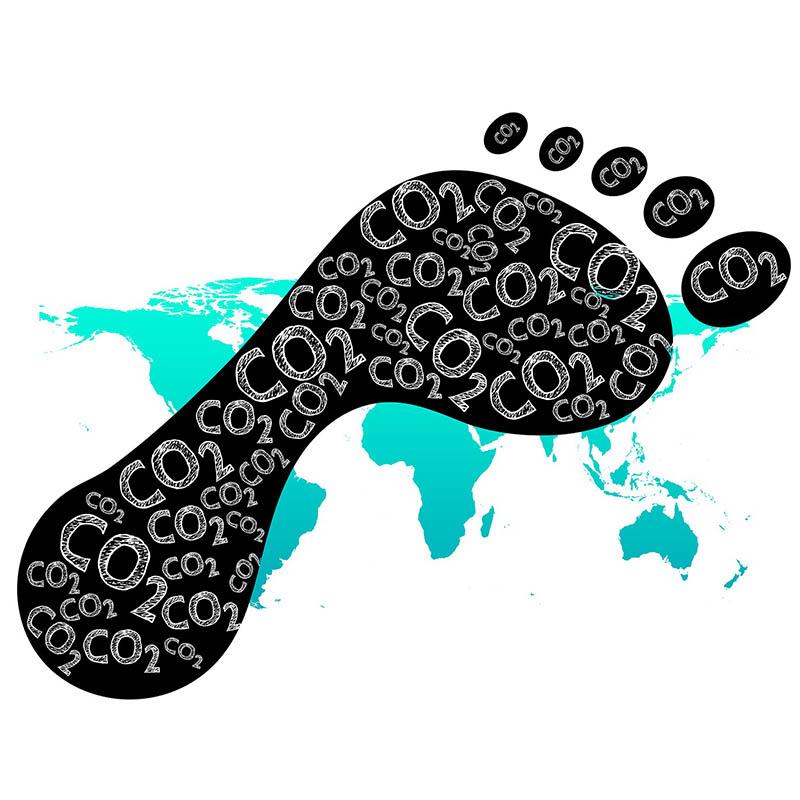CARBON FOOTPRINT: THE DIRECTIONS TO TAKE

The Paris Agreement, which came into force in November 2016, aims to contain the increase in the earth’s temperature by trying to limit the increase to 1.5 ° C.
This is only possible by gradually reducing emissions.
The carbon footprint, in English, carbon footprint, is expressed in tons of CO2 equivalent (it indicates the impact on global warming of a certain amount of greenhouse gases compared to what the same amount of CO2 should be) and determines the environmental effects that emissions (caused by products, services, organizations and individuals) have on climate change.
According to the indications of the Kyoto Protocol of 1997 (signed by more than 180 countries, on the occasion of the United Nations Conference on climate change) the greenhouse gases that must be taken into consideration are: carbon dioxide (CO2), methane (CH4), nitrous oxide (N2O), hydrofluorocarbons (HFCs), perfluorocarbons (PFCs) and sulfur hexafluoride (SF6).
Based on the category of origin of the emissions, we can identify 3 types of carbon footprint:
- Carbon Footprint of Product (CFP) includes all greenhouse gas (GHG) emissions throughout the product life cycle, from the extraction of raw materials to the final disposal of the product. The calculation can be performed by including all the phases of the life cycle or by selecting only some of them, and allows to understand the inefficiencies and weakening of the company production cycles
- Carbon Footprint of Organization (CFO, Carbon Footprint Of Organization) consists in quantifying the greenhouse gas emissions associated with the organization. These emissions can be direct (Scope 1), deriving from electricity (Scope 2) or indirect (Scope 3) i.e. subsequent withdrawal of the company’s activities, but whose source / source is controlled by other companies.
- Individual carbon footprint: amount of carbon emitted daily by an individual.

Source: Supplement to the GHG Protocol Corporate Accounting and Reporting Standard
How can the carbon footprint of the product and the carbon footprint of the Organization be calculated?
The calculation of the carbon footprint consists in quantifying the emissions of all greenhouse gases (GHG) that are converted into CO2 equivalent, through parameters established by the Intergovernmental Panel on Climate Change (IPCC).
The calculation of the carbon footprint of a good or service is regulated by the ISO 14067 standard and must take into account all the phases of the supply chain starting from the extraction of raw materials, up to the disposal of the waste generated by the system itself according to the approach Lca, i.e. the Life Cycle Assessment (or life cycle analysis). This analysis allows us to understand and quantify the waste of energy or raw materials and production inefficiencies, the elimination of which translates into a reduction in production costs.
To calculate the carbon footprint of organizations, the UNI EN ISO 14064-1 standard can be applied, or the indications of the “GHG Protocol” standard issued by the World Resource Institute (WRI) and the World Business Council for Sustainable Development can be used. (WBCSD). Both consider the GHG emissions produced directly by the organization and those indirectly generated. Quantifying company emissions also allows for a reduction in risks relating to potential future CO2 taxes.
How to reduce emissions and how to compensate them?
To reduce its impact in terms of emissions, it is necessary to reduce the use of energy, seek sustainable alternative sources (reducing the use of fossil fuels used above all for the transport of goods), increase efforts for recycling, limit travel .
However, reducing emissions is not the solution, the real goal is to offset them (carbon offsetting), eliminating CO2 in the environment as quickly as it is released.
Offsetting can take place through support for certified emission reduction projects, by purchasing carbon credits (1 carbon credit corresponds to 1 ton of CO2 absorbed or avoided by the project). These projects achieve further positive environmental and social impacts, consistent with the United Nations Sustainable Development Goals or SDGs (health benefits, biodiversity protection, gender equality and economic development).
Another way to compensate is the planting of trees that absorb CO2 during growth, transforming it into oxygen through the process of chlorophyll photosynthesis.
The latter was the choice made by Aliant Battery, a division of ELSA Solutions, which first engaged in the process of reducing its emissions, and later financed the multi-year project of planting 450 trees in developing countries.
This project has multiple benefits: environmental (increased biodiversity, trees counteract soil erosion thanks to their roots), and social (local communities receive funding, food resources and economic opportunities: they will take care of the trees and enjoy their fruits) and will lead Aliant Battery to reach Carbon Neutrality by 2030.


